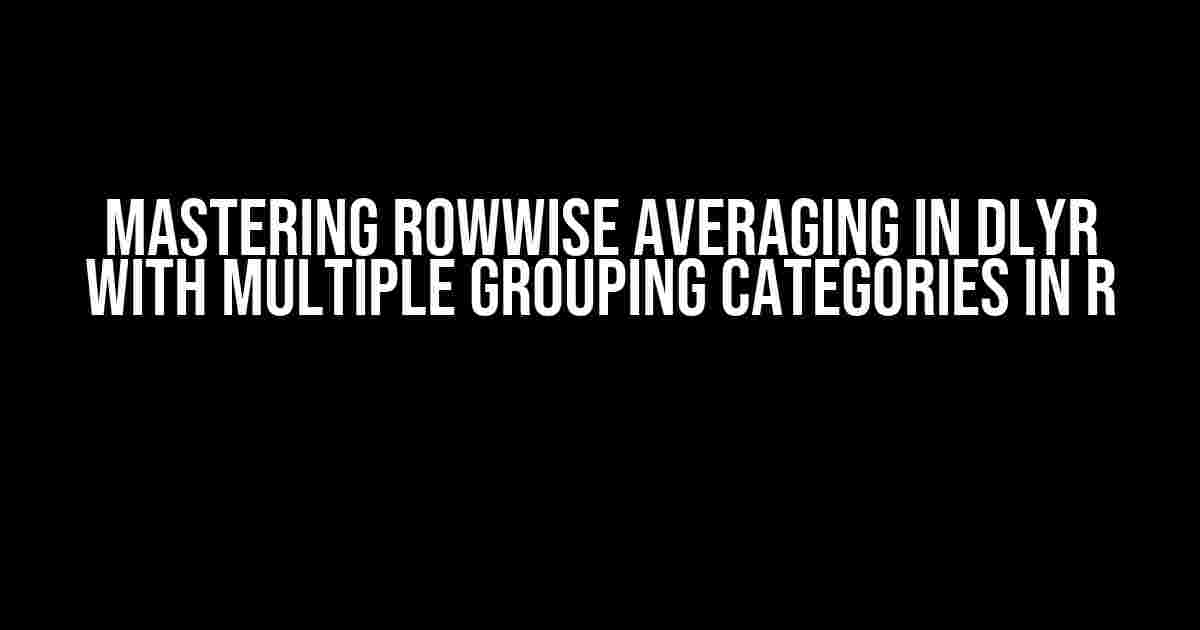Welcome to this comprehensive guide on rowwise averaging in Dlyr with multiple grouping categories in R! If you’re struggling to conquer the art of data manipulation in R, fear not, dear reader! By the end of this article, you’ll be a pro at aggregating your data with ease.
What is Rowwise Averaging, and Why Do We Need It?
Rowwise averaging, put simply, is the process of calculating the average value for each row in a dataset, often across multiple columns. This technique is especially useful when working with large datasets, where summarizing data can help reveal hidden patterns and trends.
In R, the dplyr package offers a convenient and powerful way to perform rowwise averaging. But, what happens when you have multiple grouping categories? Fear not, dear reader! We’ll dive into the world of grouping sets and explore how to tackle this challenge head-on.
Preparing Our Data
Before we dive into the world of rowwise averaging, let’s create a sample dataset to work with. We’ll use the mtcars dataset, which comes pre-installed with R.
library(dplyr)
data(mtcars)The mtcars dataset contains information on various car models, including their mileage, horsepower, and weight. We’ll use this dataset to demonstrate rowwise averaging with multiple grouping categories.
Simple Rowwise Averaging with Dplyr
Let’s start with a simple example of rowwise averaging using dplyr. We’ll calculate the average mpg (miles per gallon) for each car model.
mtcars %>%
rowwise() %>%
summarise(avg_mpg = mean(mpg))This code uses the rowwise() function to specify that we want to perform calculations on each row individually. The summarise() function then calculates the average mpg for each row.
Introducing Grouping Categories
Now, let’s introduce some grouping categories to our rowwise averaging. We’ll group our data by cyl (number of cylinders) and calculate the average mpg for each group.
mtcars %>%
group_by(cyl) %>%
rowwise() %>%
summarise(avg_mpg = mean(mpg))This code uses the group_by() function to group our data by cyl. The rowwise() function then performs the rowwise averaging within each group, and the summarise() function calculates the average mpg.
Multiple Grouping Categories
What happens when we have multiple grouping categories? Let’s say we want to group our data by both cyl and gear. We can use the group_by() function with multiple arguments to achieve this.
mtcars %>%
group_by(cyl, gear) %>%
rowwise() %>%
summarise(avg_mpg = mean(mpg))This code groups our data by both cyl and gear, and then performs the rowwise averaging within each group.
Dynamic Grouping Categories
Sometimes, we might want to dynamically specify our grouping categories based on certain conditions. We can use the across() function from dplyr to achieve this.
mtcars %>%
group_by(across(c(cyl, gear))) %>%
rowwise() %>%
summarise(avg_mpg = mean(mpg))In this example, we use the across() function to specify our grouping categories dynamically. The c() function is used to combine the cyl and gear columns into a single grouping set.
Handling Missing Values
What happens when we have missing values in our dataset? By default, dplyr will throw an error if it encounters a missing value during rowwise averaging. We can use the replace_na() function to replace missing values with a specific value, such as 0.
mtcars %>%
replace_na(list(mpg = 0)) %>%
group_by(cyl, gear) %>%
rowwise() %>%
summarise(avg_mpg = mean(mpg))In this example, we use the replace_na() function to replace any missing values in the mpg column with 0.
Common Pitfalls and Troubleshooting
When working with rowwise averaging in dplyr, it’s easy to encounter common pitfalls and errors. Here are some troubleshooting tips to keep in mind:
Error: Column ` ColumnName ` must be a vector, not a listSolution: Check that your column is not a list. Use the
unlist()function to convert lists to vectors.Error: Incompatible lengths for recyclingSolution: Check that your grouping categories have compatible lengths. Use the
length()function to verify.Error: Can't combine ` ColumnName ` <double> and ` ColumnName ` <character>Solution: Check that your columns have compatible data types. Use the
class()function to verify.
Conclusion
And there you have it, folks! Mastering rowwise averaging in dplyr with multiple grouping categories is a breeze. By following the examples and tips outlined in this article, you’ll be well on your way to aggregating your data like a pro.
Remember to keep practicing, and don’t be afraid to experiment and try new things. Happy coding, and see you in the next article!
| Function | Description |
|---|---|
rowwise() |
Specifies that calculations should be performed on each row individually |
group_by() |
Groups data by one or more columns |
across() |
Specifies dynamic grouping categories |
replace_na() |
Replaces missing values with a specified value |
This article has provided a comprehensive guide to rowwise averaging in dplyr with multiple grouping categories. By mastering these techniques, you’ll be able to tackle even the most complex data manipulation tasks with ease.
Happy coding, and don’t forget to stay tuned for more articles on mastering R!
Frequently Asked Question
Get the hang of row-wise averaging in dplyr with multiple grouping categories in R with these frequently asked questions!
How do I perform row-wise averaging in dplyr with multiple grouping categories in R?
To perform row-wise averaging in dplyr with multiple grouping categories, you can use the `group_by()` function to specify the grouping variables, and then the `summarise()` function to calculate the mean of the desired column. For example: `df %>% group_by(category1, category2) %>% summarise(mean_value = mean(value))`. This will give you the mean value for each combination of `category1` and `category2`.
What if I want to calculate the mean of multiple columns?
Easy peasy! You can calculate the mean of multiple columns by separating the column names with commas inside the `summarise()` function. For example: `df %>% group_by(category1, category2) %>% summarise(mean_value1 = mean(column1), mean_value2 = mean(column2), mean_value3 = mean(column3))`. This will give you the mean of each column for each combination of `category1` and `category2`.
How do I handle missing values in my dataset?
By default, `mean()` will return `NA` if there are any missing values in the column. To ignore missing values, you can use the `mean()` function from the `haplyr` package, like this: `df %>% group_by(category1, category2) %>% summarise(mean_value = hplyr::mean(value, na.rm = TRUE))`. This will calculate the mean while ignoring any missing values.
Can I perform row-wise averaging on multiple data frames?
Yes, you can! To perform row-wise averaging on multiple data frames, you can use the `bind_rows()` function from `dplyr` to combine the data frames, and then perform the row-wise averaging. For example: `df1 %>% bind_rows(df2) %>% group_by(category1, category2) %>% summarise(mean_value = mean(value))`. This will give you the mean value for each combination of `category1` and `category2` across both data frames.
How do I sort the result by the mean value?
To sort the result by the mean value, you can use the `arrange()` function from `dplyr`. For example: `df %>% group_by(category1, category2) %>% summarise(mean_value = mean(value)) %>% arrange(desc(mean_value))`. This will sort the result in descending order based on the mean value.



